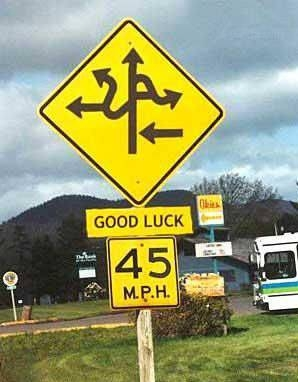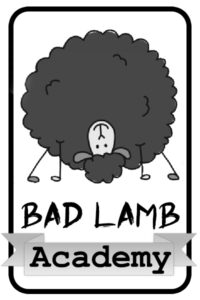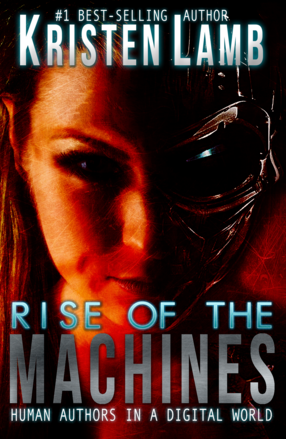All right. We’re discussing ways to fuel the muse before NaNo. Yesterday, we discussed movies and how to use them, and today we’ll delve a tad further. One of the major reasons many writers fail to complete the story is there isn’t a single CORE story problem in need of resolution. The story dies because it lacks a beating heart and a skeleton.
Stories with no hearts and skeletons are primordial adverb ooze and not good for much other than scaring small children.
A great trick NYTBSA (and spectacular writing teacher) Bob Mayer taught me was to go to the IMDB and look up log-lines of movies. Search for ones similar to the story you want to write and use it as a template.
For instance, the log-line for Romancing the Stone is:
A romance writer sets off to Colombia to ransom her kidnapped sister, and soon finds herself in the middle of a dangerous adventure.
Okay, so here is “Kristen’s story”:
An OCD accountant sets off to Mexico to find her missing little brother and soon finds herself in the middle of a dangerous adventure.
When it comes to log-lines, I would have written Romancing the Stone THIS way with this formula:
Protagonist must do X (active goal) in order to stop X (antagonist) before super bad thing happens (ticking clock).
A fraidy-cat romance author (PROTAGONIST) must travel to Columbia and partner with a shady smuggler to rescue her sister (ACTIVE GOAL) from jewel thieves (ANTAGONIST) before they feed her sister to alligators (SUPER BAD THING/ TICKING CLOCK).
Using this formula and log-line, we can use it as a pattern for my made-up-this-morning story:
An OCD accountant (PROTAGONIST) must travel to Mexico City and partner with a former Green Beret ex-patriot to save her prodigal brother (ACTIVE GOAL) from a drug cartel (ANTAGONIST) before the cartel makes him an example to other dealers who lose shipments to Border Patrol (SUPER BAD THING/ TICKING CLOCK).
I just made up this log-line, but doesn’t it speak VOLUMES about the story? Why is the accountant OCD? Is she the older child who took care of a younger brother who was out of control? The more little brother got involved with bad people, the worse her OCD became? By using “prodigal brother” we get a sense that maybe he was trying to turn his life around and leave being a user and a dealer.
Ah, but “getting out” isn’t so easy.
By saying we have an “OCD accountant” we’ve picked the WORST person to send into the filthy bowels of cartel-land, let alone partner with a Green Beret. She’s going to want to control everything and maybe even use disinfecting wipes on all things in sight (including her Green Beret friend). We see how this could easily be a thriller, a romance, or even a comedy depending on how we write it.
With just this ONE sentence, we KNOW how the story ends and where. It ends in Mexico with brother alive and drug cartel either dead or in jail. So, we know where we are GOING. This makes plotting (even very basic Pantser-Plotting) simple. If our OCD accountant ends up in Kansas instead of Mexico, we know we took a wrong turn.
There are now only so many options that lead to Mexico and finding little brother. There are only so many ways she can encounter an ex-pat Green Beret. Does he save her from being mugged? Does she HIRE him? Does he hit on her in the airport and she turns him down because his clothes are wrinkled and now she can’t get rid of him?
This log-line tells us VOLUMES about character arc, and, as the late Blake Snyder said, “Everybody arcs!”
Accountant is going to have to get over her OCD and become less controlling/neat-freakish, and maybe Green Beret needs to lighten up or even be more serious. If he’s an ex-pat, he could be running a sunglass kiosk on the beach and his motto is “Don’t worry, be happy” because he spent enough years being serious. His relaxed manner might drive her insane.
Formula for AWESOME conflict.
By looking at the IMDB, we can check out movies we loved and likely find there was a solid core story problem (code for “good log-line”). Most of the movies we hate? The ones where we are all like, “Great, two hours I can NEVER get back.” Odds are? Crappy log-line.
Worst….movie….ever (and I don’t give a rip what Sundance says). Melancholia. But I should have known from the log-line:
Two sisters find their already strained relationship challenged as a mysterious new planet threatens to collide with Earth.
Who is the protagonist? There ISN’T one (trust me on this). What is the active goal? Again, NOT THERE. “Finding a strained relationship challenged” is NOT AN ACTIVE GOAL.
It’s a sentence for misery.
The movie is literally two sisters b!tch!ng at each other until everyone dies….and there was much rejoicing because I hated everyone in the movie and was happy they were all obliterated.
Yes, there is a super bad thing/ticking clock (a mysterious planet threatens to collide with the Earth) but there is NO WAY TO STOP IT. So the viewer is trapped with the Family from HELL until everyone dies.
The end.
ARRRRGGGGGGGHHHHHHHHHH!
We can learn a lot about what TO DO by studying what NOT TO DO. Yeah, yeah, Melancholia was pretty and had great cinematography and if you watch the movie on MUTE, it probably rocks. But for story? Not there. Trust me. This is three and a half hours of my life I will never get back AND $15 because I was stupid enough to BUY the movie and I can’t even regift it because there is no one I hate that much.
Sorry if I have offended any readers who LOVED Melancholia.
But, feed your muse a solid log-line to keep hold of and this will help you spot Bunny Trails of DOOM far easier. It will keep you on track and make that 50,000 words something solid that can be revised, because there will be the bones and beating heart of an actual story beneath all the superfluous description, poor dialogue or small rabbit trails all of us have to edit out later.
What are your thoughts? Does this formula help? What are some of the best/worst movies you have seen? Can you tell a stinker from the log-line?
I LOVE hearing from you!
To prove it and show my love, for the month of October, everyone who leaves a comment I will put your name in a hat. If you comment and link back to my blog on your blog, you get your name in the hat twice. What do you win? The unvarnished truth from yours truly. I will pick a winner once a month and it will be a critique of the first 20 pages of your novel, or your query letter, or your synopsis (5 pages or less).
Also, for all your author brand and social media needs, I hope you will check out my new best-selling book Rise of the Machines—Human Authors in a Digital World.











71 comments
13 pings
Skip to comment form
Ha, that’s fantastic. I’m going to remember that facial expression the next time I greet a visitor here at work. Have to remember that there’s a formula for everything, no matter how creative we get with the plug-ins. Great tips – tweeted! (Because I pretty much consistently tweet all of your articles).
Author
GO KRISTENS! Thanks for the support ((HUGS)).
I’m going to give your “sentence” a try. I already use a variant, Protagonist vs Antagonist, in a setting with a conflict and a twist. Sometimes trying something just a little different will get the Muse working. Thanks for the tip.
I tried it and, wow! The logline technique helped me think about what’s at stake in the story in a way nothing else has. Thanks!
Great teaching = “We can learn a lot about what TO DO by studying what NOT TO DO.”
And I’m totally trying this new tool!! Thanks!
I really like the idea of thinking of your characterization and plot as a movie tag line. Thanks for the advice!
Author
Hey, I learned it from Bob Mayer. Passing on the love <3
How’s this for a log line for my NaNo project:
The timid trophy wife of the most powerful man in the galaxy must put her life on the line in order to stop an act of personal revenge that will slaughter billions in the name of economic stability.
Author
Sounds good to me.
Awesome post Kristen. Made me LOL. I love that picture, I never heard of that movie. Sounds like a good thing to me. 🙂
LOL @ not hating anyone enough to regift them with “Melancholia”–maybe you can regift it to the first responder that is offended—they would love it and you’d be rid of it. Win-win. :~) Loved checking IMBD log lines and applying the formula. Hated seeing some of my all-time favorites with dismal ratings–but realized, if my plots are like the ones in my favorite movies there might be a reason for the fizzle I’m experiencing…and maybe I need to watch better crafted movies. Thanks as always for great advice. ~Rethinking, regrouping, and reimagining prior to NaNo.
Author
Sometimes the idea is still great, just the filmmaker might have executed poorly. When it comes to films other things come into play, like acting, etc. But if you loved the story, WHY?
Thanks for reminding me that I love playing with log-lines. 🙂
I’ll have to try the IMDB logline thing. I tend to look through synopses on goodreads and get ideas from them. Like taking one aspect of a book and mixing it with something from another. Or taking a general idea and spinning it completely differently. The novel I wrote earlier this year (that is sitting in limbo) came from the synopsis for a book called I’m Not Her by Janet Gurtler about a younger sister that has to take the place of her sick older sister in the sister’s group of friends.
My book is about a girl that dies and the younger sister and the dead girl’s boyfriend have to figure out how to deal with their grief. They can’t stand each other but figure out that they are the only two that understand and become friends. It’s in limbo because it doesn’t have a real storyline.
Author
Yes, because “dealing with grief” isn’t an active goal. Has to be tangible. Even in literary fiction. In The Road, the tangible goal is to make it to the ocean. That’s it. But they must make it without losing their humanity. It’s literary because the character goal is more important than the plot goal. If they make it to the ocean, but resort to eating other people, they have failed. But, there are STILL antagonists and STILL a solid core problem.
Yeah, I’m pretty sure that’s why the story fizzled and I put it away before it drove me nuts. I don’t know a real goal for the characters. I guess the point of the story is that they end up together. It’s a love story. But I don’t have a true antagonist or goal. In my initial planning it seemed the antagonist to the girl was herself because she wouldn’t let herself feel for anyone, pushed everyone away and wanted to be alone despite needing someone to talk to about her sister’s death.
Still not sure what to do with the story.
Author
The plot problem is the catalyst that gets her to face that darkness, though. Otherwise there isn’t a story because there is no conflict, just melodrama.
Really good reminder about the need for an active goal in the story – thanks for that. And your comment about how your protagonist is ill-suited to the goal, making for more conflict and excitement, reminds me of something Mary Robinette Kowal has suggested a couple of times on the writing excuses podcast. She says that, when writing sci-fi and fantasy, a good way to pick a protagonist is to think about who would be worst affected by what’s different about this sci-fi / fantasy world. Essentially, it’s picking the person who already struggles the most, who’s probably least suited to handle the situation, who’s got that built in struggle. I’ve found that it’s often a good starting point.
OK, question: I get the “equation” you used for loglines and how they would work for action stories but what if the story isn’t about antagonist battling protagonist for whatever before something bad happens?
How would you write a logline for my NaNo project: there are two “protagonists” (boy who is competitive and NEVER loses and a girl who is an introvert and wants mostly to be left alone) who are also each other’s antagonists. They have to work as a team to complete a scavenger hunt over the summer to win $1000 (the boy wants to win just because he wins everything, the girl needs the money for something important).
Author
Still need a core antagonist (BBT) to be defeated in Act Three or no story. Also, there really is only ever one protagonist. All others are allies (supporting actors). One has to be the antagonist because they both want the same thing and working as a team is a fizzling end. They can come together AGAINST, say a rich bully who cheats (ANTAG/BBT), but a story with two protags and no antag isn’t a story, just prose.
I said 2 protagonists because the story is written from both POVs. But if there can only be one, which one is it? I made a blog post and was working on loglines and when I wrote them up for this story I did one for each POV character and it ended up being that one character was the protagonist and one was the antagonist in each case (just slipped).
I guess there’s a character called Tommy that is kind of a rich bully. He’s the one that creates the challenge and pairs the boy and girl together because he knows the boy likes to win and the girl doesn’t want to participate which he hopes will force the boy to lose. I guess he’s the antagonist?
I think I get myself confused because on one hand there’s the external goals (which is what I used for the loglines) but the internal goals come out as the characters get closer and start to fall for each other and in the end the boy’s goal is to not lose the girl. If that makes sense.
Author
Then she is the protagonist and he is the love interest (ally). Similar to romance, but with young people. But they still have to have a tangible goal and come together to solve the core story problem and defeat the antag’s agenda (win the treasure hunt).
Thanks for all your comments/help. I totally get what you are saying but I’ve always had trouble visualizing things when there isn’t a sure adventure plot.
I’ll have to do some deep thinking about a mutual antagonist and a better goal. You’ve given me a lot to think about for both stories. Greatly appreciated.
Love this, Kristen! A quick way to look at your story to see if it’s crap instead of getting half way through and then thinking, “Man this sucks!”. I’m going to test it on the story I’m writing for NaNoWri.
Yet another great article and advice, I am heading over to Imdb right now to find ‘my movie’
Great advice. I’m going to look up some non-action type of movies to see what they say.
This is great advice for condensing a story to its most basic premise. If you don’t have interesting characters, a conflict, and some terrible fate to avert, why would anyone care enough about the story to get invested?
I use a similar method to yours, which I’m prepping for my NaNoWriMo project. I write a logline for each of the most important characters and treat each of them, even the villain, as if they’re the hero of their own story. I get all sorts of ideas for cool plot points and how to weave their stories together as I go.
“I write a logline for each of the most important characters and treat each of them, even the villain, as if they’re the hero of their own story.”
GENIUS.
I must steal this. And use it. Everywhere.
I stole it from David Farland, so that sounds fair. 😉
Thanks Kristen. I now realize I have no real antagonist in a story Idea I have. It’s a murder mystery that a couple is trying to solve a hundred years later. There’s no one around now who gives a fiddle if it’s solved, because it won’t affect them, except the ghost.
Super advice! And I loved your rant. Thanks, I *won’t* watch Melancholia (the title says it all – ugh).
Just wondering if it is really, really important for the Protag to physically go somewhere else? I understand the Hero’s Journey aspect of all stories. Might physically leaving be replaced by remaining to struggle against the social issues or culture? I don’t mean the Antagonist is simply the culture, or society – I believe stories are better when the Antagonist is an actual character.
Here’s a really rough logline for my WIP: “When a woman running for public office is found split into good and evil halves, Xironi the space mage catgirl helps her friend Carda conceal the girl’s secret while they try to rejoin her halves. But is this even possible as the evil half works to sabotage the election so the dark mage who split her can escape his magical prison?”
One of the running jokes is that, if the evil half wins the election, will anybody notice? 😀
Here’s a stab at condensing it to something you could post on Twitter in one go (a rule of thumb I like to use on my log lines):
A catgirl mage and her friend must help a woman split in two merge her halves before a dark mage wreaks havoc on the galaxy.
What do you think? Distilled enough? Too much?
Author
Works for me 😀
Kirsten, this has been so helpful and now I actually feel that I can see my way forward. Thank you so much 🙂
I’m so sorry I mis-spelt your name in my earlier comment.
That’s a top tip, thanks – I’m already having fun with this technique.
I hadn’t thought of combing IMDB – thanks for the tip.
My WIP log-line is currently “A naive princess must find the lost crown jewels and win the people’s support before her usurping uncle hunts her down and kills her.”
I’d love to hear what you think!
Kristen, I really loved your post today (as I usually do.) I was really excited to hop over to IMDB and check out all my favorite movies on IMDB, and check them against Bob Mayer’s formula, but lo-and-behold I did not discover the formula in action in the tag lines. All the movies I chose (all highly rated movies) seemed to be missing some element or another of the formula. So I went to IMDB’s list of the top 250 and applied the formula to the top 5 movies (and beyond) and once again did not see all the elements in the tagline. These are all, by any standards, great movies, but what am I missing? Are they badly written taglines, or are there other formulas for a good story that you aren’t telling us about? Am I daft?
So let’s take a closer look:
1. The Shawshank Redemption – “Two imprisoned men bond over a number of years, finding solace and eventual redemption through acts of common decency.”
Protagonist(s) – Two imprisoned men
Active Goal – Finding solace and redemption??? I’d argue this is a very weak goal, much like your example of “finding a strained relationship challenged” from Melancholia. Since I know this movie pretty well, I’d say the Protagonist’s main goal is to “escape prison” – aww, but the problem is, you don’t want to give away the ending in the tagline…
Antagonist – ??? Their imprisoners? The prison system? The government? One does not seem to be explicitly stated.
Super Bad Thing/Ticking Clock – ??? Again, not explicitly stated. Would it be, continued imprisonment?
2. The Godfather – “The aging patriarch of an organized crime dynasty transfers control of his clandestine empire to his reluctant son.”
Protagonist – Aging patriarch of an organized crime dynasty
Active Goal – Transferring control of clandestine empire? Sounds like an awfully boring goal.
Antagonist – ???
Super Bad Thing – ???
I am not as familiar with The Godfather (GASP!), so I’m not entirely sure that the aging patriarch (Don Vito Corleone) is the protagonist (is it the son Michael that is the protagonist?)
3. The Godfather Part II – “The early life and career of Vito Corleone in 1920s New York is portrayed while his son, Michael, expands and tightens his grip on his crime syndicate stretching from Lake Tahoe, Nevada to pre-revolution 1958 Cuba.”
Protagonist – Not really sure…Vito? Michael?
Active Goal – Tighten grip on crime syndicate?
Antagonist – ???
Super Bad Thing – ???
4. Pulp Fiction – “The lives of two mob hit men, a boxer, a gangster’s wife, and a pair of diner bandits intertwine in four tales of violence and redemption.”
Protagonist(s) – Two mob hit men, a boxer, a gangster’s wife, and a pair of diner bandits (seems like a lot of Protagonists)
Active Goal – Violence and Redemption???
Antagonist – ????
Super Bad Thing – Violence and redemption?
5. The Good, the Bad, and the Ugly – “A bounty hunting scam joins two men in an uneasy alliance against a third in a race to find a fortune in gold buried in a remote cemetery.”
Protagonist(s) – Two men in an uneasy alliance
Active Goal – find a fortune in gold buried in a remote cemetary
Antagonist – third man
Super Bad Thing/Ticking Clock – ? Maybe, losing the race…
This is definitely the closest of the 5 to the formula.
Author
But if you look at the others, since YOU have already seen them and don’t want to “give away” anything, you could likely plug them into that formula, much like I did with Romancing the Stone. Finds adventure? Okay, nebulous. But since I KNOW the movie, I can take what the IMDB presented, tweak, then work off it as a template.
A-ha…okay thank you! Makes more sense now.
I haven’t seen *The Godfather*, but how willing is the son? If he’s reluctant, there’s a lot of conflict in the father wanting to perserve his dynasty before he croaks, and the son trying to avoiding that life.
I love my loglines too, through I prefer to use them to shoehorn my incredibly *ahem* creative plots into something workable. I also find them useful for codifying subplots, and I can usually visualise which is most important based upon how terrible the ticking clock is. A very useful tool indeed.
I wish I’d met your blog early on in my journey toward publication. I made plenty of fluffy bunny trails all over the place because I had no idea about things like log lines and how important they are. Now I tell other authors to write them and their pitch blurbs and synopsis, because all these things help to figure out what your story is truly about and if it is anywhere close to interesting. Great advice once again. Love it.
I looked up that memorable stinker: Synecdoche NY, the very name should have been a clue. “A theatre director struggles with his work, and the women in his life, as he creates a life-size replica of New York City inside a warehouse as part of his new play.” Can you say existential angst masquerading as plot?
As a side point, I love the cultural diversity visible in movie credits. Anoveros, Bhagwat, Boyarsky, Buccatello, Burnham, Cadieux, Chan, Choudhari, Constanza, Czekanski to pick out a few from Synecdoche NY. If you want more diversity in the supporting cast of your book, look at movie credits.
I’m reading your marketing book, so the Blog is a treat, and its a pleasure to leave a comment
Meet My Wife with Jennifer Anniston was HORRIBLE!!!!
Hi,
I enjoyed your post. Of course this makes perfect sense. One pet peeve of mine in recent years has been the lack of a riveting “complete” storyline, both in books and movies. There too often seems to be so much focus on the action or emotional aspect that all too soon the end is near and the author/director rushes us into a neat and tidy finale that completely leaves me flat. I recently saw Insidious 2; and although I love scary movies, I am not a fan of most recent attempts. This movie kept me glued, enthralled and hooked until the very end. It completed the story as well as leaving the door open just a crack for the next sequel. I can only hope it turns out as well as this one because I am not a sequel fan either. As for Melancholia, I agree. But, am I the only one who noticed you misspelled Ms. Dunst’s first name? It is, indeed Kirsten, although I love the name Kristen! :)) She has that look in a lot of movies. Thank you for the wonderful tips.
Author
No, I was referring to ME. No misspelling. That was KRISTEN’S (MY) face the entire time. Just our names are close :D. And yeah, that was her face almost the entire time, too.
Oh, ok, got it. Thanks. I just got locked into that permanent scowl. Perfect.
Nice tips, although I’m not sure story structure is always this idealistic. Consider the plots of “The Blind Assassin,” “A Complicated Kindness,” “The Poisonwood Bible,” or “A Separate Peace.” Or perhaps you’re right and the “ticking clock” is more subtle. Either way, you’ve encouraged me to review my own.
I think I need to have time to mull over/develop my characters before I throw them together in a pitch like this, but If I’m creating great 3-D people and have an idea of the genre I want to put them in, then the logline can really zing. And provide focus, of course! Bookmarking this for next summer, when I’ll finally be out of college and able to write what I want. 🙂
Great formula! I’m going to suggest it to my friend who is writing queries right now. I’m not sure she is selling her novel clearly, and I was having a difficult time trying to figure out what was missing: Protagonist, Active Goal, Antagonist, and Super Bad Thing/Ticking Clock.
I LOVE this formula. It is clear, concise and simple. I will definitely use it to my advantage I hope. You are very encouraging, Kristen. Thanks.
http://warriorwriters.wordpress.com/2013/10/16/fueling-the-muse-for-nanowrimo-part-one/
I’m so glad I never watched Melancholia but enjoyed your description of it. Laughed out loud. Talk about a formula for the goal of eat, drink and be merry for tomorrow we will die.
Very good formula. I’m going to work it up for my planster outline for Nano.
Reblogged this on Echoshadow.
LOL I LOVE the idea of her turning him down in the airport and then she can’t get rid of him. Is he her stalker or her savior? Love it more if she doesn’t know he’s a green beret and the skills come out of nowhere when she needs them. “How did you learn to do THAT?”
I used this technique and it really cleaned up my outline. Thanks so much for the suggestion, Kristen! I mentioned {and linked to} this in my NaNo Prep post – hopefully it helps others as well as it helped me!
{http://www.theworld4realz.com/nano-prep-tips-nanowrimo-nanoprep-row80/}
This is about MY expression – every day – from when I get up until when I go to sleep. *sigh* – Maybe I should buy a mirror…
I absolutely loved this post Kristen! I’m doing NaNo in November and will definitely be trying out this idea to help me along. You are such an inspiration. Thank you. Lily
I read this yesterday, and just picked myself up off the floor so I could comment. I wish I’d seen this advice before I started any project, ever. At least I can use it going forward. Having a concise logline will help with the edits I’m starting now. Heck, I might even get my word count down if my story goals are clearer, and that’s always a good thing, right?
I’m glad I read this before nanowrimo started. =) The story I’m working on is urban fantasy and it involves magical cities that are hidden within human cities ruled by ‘lesser’ gods and goddesses. The main protagonist is one of these gods and his power is being stolen by a demi-god who wants to become a full god and eventually replace the goddesses of creation and death. If he succeeds both the magical city and the human city will be destroyed.
It sounded great when I came up with it but as it gets closer to November I’ve been having doubts.
Great blog thanks especially for all the NaNoWriMo advice–I’ve tried and failed twice, sidetracked the first time by a relative’s serious illness and the second time by my own loss of focus. I’ve got the blinders on this year. Your insights are helpful and encouraging. I feel like I should be hopping around, shaking my arms and shoulders like a boxer before a match.
“…because I was stupid enough to BUY the movie and I can’t even regift it because there is no one I hate that much.”
Ha!
Thanks for the reminder about loglines! We had to create those in my playwriting class in college, and I can’t believe I didn’t think about using one as a basic outline for my story. It’s so true. A logline can really help in making the story. Off to write mine now… 😉
Excellent article. I’m struggling with this though. I’m working on a story sort of like Secondhand Lions or Big Fish. Both of their log lines are pretty weak, and neither really has a goal. Now I’m a bit worried.
I went to IMDB and found lots of bad loglines, on lots of good movies. The problem isn’t the movie, it’s badly written loglines. Kristen responded to my post and suggested that if you know the movie, then write your own logline.
That’s a great idea, I’ll try that.
100% agreed on Melancholia. The camera shaking could bring on a migraine and the horrible character development had me turning it off after about an hour. I didn’t care that a planet was plummeting toward Earth at them. This was a great example of how NOT to write. And your article was very helpful and fun to read. Thanks for sharing. NaNo on everyone! 😀
Reblogged this on Darswords and commented:
I love Kristen Lamb’s Blog!
Wow. I’ll try to use that while I’m doing my last-minute planning tomorrow!! Thanks for the advice on the blog!!
[…] I gain inspiration from Kristen Lamb’s Blog. This time she’s talking about using “loglines” to test your story premise and make sure it has heart and a backbone. Loglines are the oneliner […]
[…] Image via Flikr Creative Commons. Bansky’s “Peaceful Hearts Doctor” courtesy of Eva Blue. All right. We’re discussing ways to fuel the muse before NaNo. […]
[…] « Fueling the Muse Part 2—How to Give Your NaNo Story a Beating Heart and a Skeleton […]
[…] recent post by amazing author Kristin Lamb got me thinking about the value of being able to clearly and […]
[…] My next step in outlining? Write a log-line: a one-liner that captures the basic premise of the story, per advice from Kristen Lamb {Read: “Fueling the Muse Part 2—How to Give Your NaNo Story a Beating Heart and a Skeleton“}. […]
[…] How to Give Your NaNo Story a Beating Heart and a Skeleton […]
[…] Fueling The Muse Part 2 – How To Give Your NaNo Story A Beating Heart and a Skeleton […]
[…] dream of ever reaching it (well, until the end, of course). Remember, last week we talked about the Big Boss Troublemaker and log-lines. Generally (in genre novels especially), it is the BBT is who’s agenda will drive the […]
[…] Fueling the Muse Part 2—How to Give Your NaNo Story a Beating Heart and a Skeleton […]
[…] just read Fueling the Muse Part 2—How to Give Your NaNo Story a Beating Heart and a Skeleton, which describes using the log lines from movies on IMDB to get a feel for a story's […]
[…] this up with Lamb’s “How to Give Your NaNo Story a Beating Heart and a Skeleton” which uses a basic log-line to focus in on the core problem of your story—and […]
[…] mean you have to write an outline that’s 20 pages long. A short list of plot points or even a single log-line that tells the main thrust of the story can qualify as a […]
[…] Kristen Lamb with Fueling the Muse Part 2—How to Give Your NaNo Story a Beating Heart and a Skeleton […]